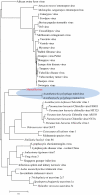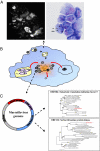Giant Marseillevirus highlights the role of amoebae as a melting pot in emergence of chimeric microorganisms
- PMID: 20007369
- PMCID: PMC2799887
- DOI: 10.1073/pnas.0911354106
Giant Marseillevirus highlights the role of amoebae as a melting pot in emergence of chimeric microorganisms
Abstract
Giant viruses such as Mimivirus isolated from amoeba found in aquatic habitats show biological sophistication comparable to that of simple cellular life forms and seem to evolve by similar mechanisms, including extensive gene duplication and horizontal gene transfer (HGT), possibly in part through a viral parasite, the virophage. We report here the isolation of "Marseille" virus, a previously uncharacterized giant virus of amoeba. The virions of Marseillevirus encompass a 368-kb genome, a minimum of 49 proteins, and some messenger RNAs. Phylogenetic analysis of core genes indicates that Marseillevirus is the prototype of a family of nucleocytoplasmic large DNA viruses (NCLDV) of eukaryotes. The genome repertoire of the virus is composed of typical NCLDV core genes and genes apparently obtained from eukaryotic hosts and their parasites or symbionts, both bacterial and viral. We propose that amoebae are "melting pots" of microbial evolution where diverse forms emerge, including giant viruses with complex gene repertoires of various origins.
Conflict of interest statement
The authors declare no conflict of interest.
Figures





Similar articles
-
Giant virus vs amoeba: fight for supremacy.Virol J. 2019 Nov 4;16(1):126. doi: 10.1186/s12985-019-1244-3. Virol J. 2019. PMID: 31684962 Free PMC article. Review.
-
Mimiviridae: clusters of orthologous genes, reconstruction of gene repertoire evolution and proposed expansion of the giant virus family.Virol J. 2013 Apr 4;10:106. doi: 10.1186/1743-422X-10-106. Virol J. 2013. PMID: 23557328 Free PMC article.
-
Giant Viruses of Amoebae: A Journey Through Innovative Research and Paradigm Changes.Annu Rev Virol. 2017 Sep 29;4(1):61-85. doi: 10.1146/annurev-virology-101416-041816. Epub 2017 Jul 31. Annu Rev Virol. 2017. PMID: 28759330 Review.
-
Complete genome sequence of Courdo11 virus, a member of the family Mimiviridae.Virus Genes. 2014 Apr;48(2):218-23. doi: 10.1007/s11262-013-1016-x. Epub 2013 Dec 1. Virus Genes. 2014. PMID: 24293219
-
Isolation and Identification of a Large Green Alga Virus (Chlorella Virus XW01) of Mimiviridae and Its Virophage (Chlorella Virus Virophage SW01) by Using Unicellular Green Algal Cultures.J Virol. 2022 Apr 13;96(7):e0211421. doi: 10.1128/jvi.02114-21. Epub 2022 Mar 9. J Virol. 2022. PMID: 35262372 Free PMC article.
Cited by
-
Welcome to pandoraviruses at the 'Fourth TRUC' club.Front Microbiol. 2015 May 18;6:423. doi: 10.3389/fmicb.2015.00423. eCollection 2015. Front Microbiol. 2015. PMID: 26042093 Free PMC article.
-
Human gut microbiota: repertoire and variations.Front Cell Infect Microbiol. 2012 Nov 2;2:136. doi: 10.3389/fcimb.2012.00136. eCollection 2012. Front Cell Infect Microbiol. 2012. PMID: 23130351 Free PMC article. Review.
-
Medusavirus Ancestor in a Proto-Eukaryotic Cell: Updating the Hypothesis for the Viral Origin of the Nucleus.Front Microbiol. 2020 Sep 3;11:571831. doi: 10.3389/fmicb.2020.571831. eCollection 2020. Front Microbiol. 2020. PMID: 33013805 Free PMC article.
-
The Discovery of a New Mimivirus Isolate in Association with Virophage-Transpoviron Elements in Brazil Highlights the Main Genomic and Evolutionary Features of This Tripartite System.Viruses. 2022 Jan 21;14(2):206. doi: 10.3390/v14020206. Viruses. 2022. PMID: 35215800 Free PMC article.
-
Viral Complexity.Biomolecules. 2022 Jul 30;12(8):1061. doi: 10.3390/biom12081061. Biomolecules. 2022. PMID: 36008955 Free PMC article. Review.
References
-
- Lwoff A. The concept of virus. J Gen Microbiol. 1957;17:239–253. - PubMed
-
- Raoult D, Forterre P. Redefining viruses: Lessons from Mimivirus. Nat Rev Microbiol. 2008;6:315–319. - PubMed
-
- Van Etten JL, Meints RH. Giant viruses infecting algae. Annu Rev Microbiol. 1999;53:447–494. - PubMed
-
- La Scola B, et al. A giant virus in amoebae. Science. 2003;299:2033. - PubMed
Publication types
MeSH terms
Associated data
- Actions
Grants and funding
LinkOut - more resources
Full Text Sources
Other Literature Sources
Molecular Biology Databases

